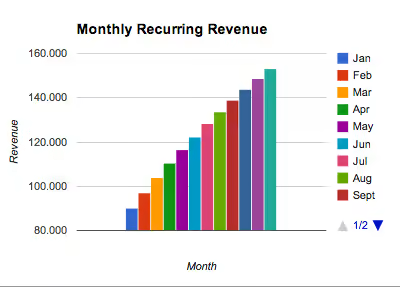What can Online marketing agencies learn from the SaaS community regarding growth and profitability? The SaaS (software as a service) community is well educated in concepts like ‘Growth Hacking’, “Customer acquisition” and “Customer retention”. Since most online marketing agencies work on a subscription based model for their clients these concepts could well apply for Swydo users too. Apply valuable lessons from the SaaS community in your Agency now.

Do you measure your customer acquisition and retention with SaaS based metrics? Let’s see what online marketing agencies can learn. We start with a first metric that calculates what investments you have to make to get one client onboard.
CAC – the Cost to Acquire a typical Customer
The CAC includes marketing costs, sales and some overhead.
Do you use some Adwords yourself to generate traffic and you have a sales rep calling the leads and drafting proposals? Count these costs all as a part of your CAC. So if an average CPC in Adwords is $1 and you generate 1 qualitative lead with 100 clicks and your rep needs 4 leads to sign a customer your marketing expenses are $400 per customer.
Next to the marketing costs we have the sales costs. Lets say your rep earns $5.000,- a month including all expenses and he onboards 6 clients a month, then the sales costs are 5000/6 = $833 per customer. The combined marketing and sales costs, the CAC – the Cost to Acquire a typical Customer, are 833+400=$1.233 in this example. Do you have your CAC calculated? You should have this clear.
Is the CAC acceptable or is it too high? You can only give an answer to that question when you take into account what the customer will bring you during the lifetime he will be a customer: the LTV.
LTV – the Lifetime Value of a typical Customer
How long does the average customer stay with your agency and what is the average value that is generated. Assume a customer that stays with you for 20 months on average and pay’s $400 a month. then the LTV is 20×400=$8.000.
These two metrics, CAC and LTV, have a strong relation to each other. Lets say that the CAC is $1.233 and the LTV is $8.000. Then the LTV to CAC ratio is 8.000/1.233= 6,5 . The best SaaS businesses have a LTV to CAC ratio that is higher than 4, sometimes as high as 7 or 8. In case of a services business that Adwords management is, compared to the software business the LTV to CAC ratio should be higher then 6. What’s your LTV to CAC ratio?
Months to Recover CAC
The other aspect is Months to Recover CAC. Lets say that the monthly turnover of this customer is $400. Then it takes 3 months to recover from the investment of $1.233 in customer acquisition. In month 4 you will start to make profits on this individual customer. In the SaaS business a max of 12 month is a norm, but in the services business this should be 6*(see why I corrected this below), but I would advise to target 3 months to the max. If it gets higher you will have a cash flow problem. You have to invest too much too long before you earn back.
Monthly Recurring Revenue MRR
Your Monthly Recurring Revenue is basically what you can bill your customers based on your subscription based model. In your clients portfolio there is a mix of current customers, new customers, expanded customers (they upgrade) and churned customers. In the mix your MRR gives you insight in the financial strength of your business.
Looking with these SaaS metrics in mind to your marketing and sales process can give you guidelines to develop a marketing and sales dashboard. This dashboard you can use in your management meetings. I developed a short model in Google Spreadsheets, that can be used, copied and modified to your needs. Open the spreadsheet and play around with the green variables, like CPC, hourly rate of your consultants or # sales reps and see the effect on your CAC, LTV, MRR and not to forget your profits/EBITDA. You can see the devastating effect of low customer satisfaction (high churn, short LTV) or not investing on sales reps.
Open the sheet in Drive here .
* Correction for Saas – Services with factor 2.
I corrected the generally accepted SaaS metrics norm to the Services business with a factor 2, because in Software the operational cost of an extra customer has a different pattern then in Services. In the services business an extra client to manage an Adwords account, actually takes some hours from a consultant! (Not to say we in the software business are lazy 🙂 or money comes in for free, but software scales differently ). Based on an average hourly rate of $100 (mixed junior/senior) a SMB account that generates $400 in revenue will have a consultant working on the account for 4 hours. Let’s say that the PPC manager cost on average $6.000 a month and work effectively 120 hours, than the gross profit for one hour billed to the customer is $100 -/- (6.000/120=50) = $50.
(This blog post is highly inspired by SaaS Metrics 2.0 – A Guide to Measuring and Improving what Matters, Blog post by David Skok).
